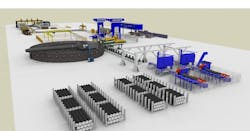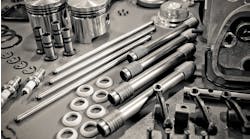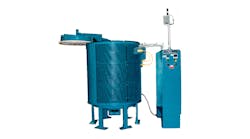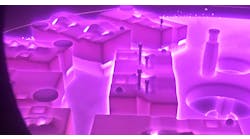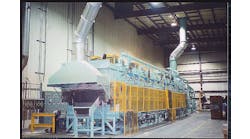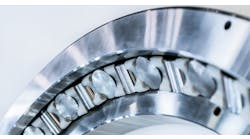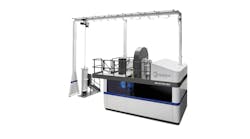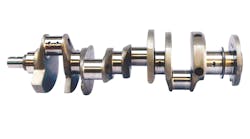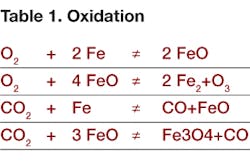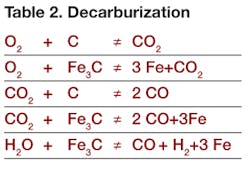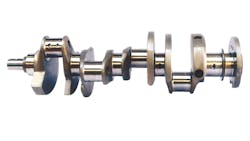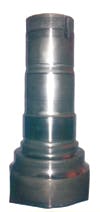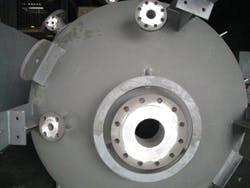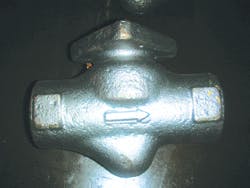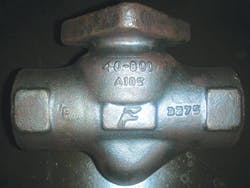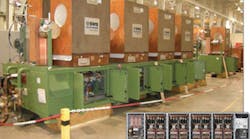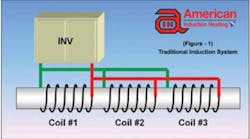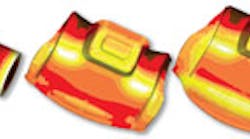Latest from Heating
Heat Treating Cost Reductions Due to Protective Coatings
Heat treatment is an important step in the manufacturing of engineering components, machine parts and tools. Oxidation and decarburization of steel will take place when steel is heated in an electric furnace or oil-fired furnace, in the presence of air or products of combustion. Oxidation leads to numerous problems, like scale pit marks, loss of dimensions, poor quality surface finish, quench cracking, an increase in expensive processing (like shot blasting, machining and acid pickling) — and even to rejection of finished products.
Protection against scaling and decarburization is achieved by heating in molten salts, fluidized bed furnaces, protective gaseous media, or vacuum furnaces. These measures demand significant capital investment, highly skilled personnel, and special safety precautions. Many companies cannot afford them, and yet they are under mounting pressure to prevent oxidation and decarburization.
This article introduces a practical technique that enables any kind of steel to be heated without the basic problems of oxidation and decarburization. The technique, established in a number of hot forging units, heat treatment shops and hot rolling mills, can be adopted by both small and large scale units.
Understanding Oxidation and Decarburization
When steel is heated in an open furnace in the presence of air or products of combustion, two surface phenomena will take place, oxidation and decarburization. Oxidation of steel is caused by oxygen, carbon dioxide and/or water vapor. The general reactions are given in Table 1.
Decarburization or depletion of surface carbon content takes place when steel is heated to temperatures above 650°C. It progresses as a function of time, temperature and furnace atmosphere. The typical reactions involved are shown in Table 2.
The effects of oxidation and decarburization range from physical to economical, and include
• Deteriorated surface quality due to pitting.
• Loss of material and dimensions as extra material allowance needs to be kept for scaling.
• Non-uniform metallurgical transformation during austenitizing and subsequent quenching. Lowered surface hardness and strength due to layer of scaling.
• Reduced fatigue strength of heat treated product (especially true in case of automobile leaf springs.)
• Costly and time consuming operations like shot blasting, pickling and grinding to remove scaling and remove decarburized layer.
Preventing oxidation and decarburization is not only better than any cure, it is profitable, too.
There are several ways to address problems caused by the two harmful reactions. Decarburized surface removal by machining operations after heat treatment, copper plating of thickness up to 0.025 mm prior to heat treatment, or change of heating media to molten salt bath, are some ideas. A number of protective atmospheres may be introduced like liquid hydrocarbon, dissociated ammonia, exothermic gas, nitrogen and endothermic gas. Fluidized bed furnaces and vacuum furnaces have also proven to reduce scaling. Switching to grades that do not require heat treatment is possible in rare cases.
However, most of these proposed solutions pose a number of problems or practical difficulties. Availability of capital and human resource for using high-end furnaces is a major issue. Many small heat-treatment shops cannot afford these solutions. Yet, they are under mounting pressure to prevent oxidation and decarburization. Using protective anti-scale coating has proven to be a logical solution to the problem of scaling and decarburization.
Benefits of Anti-Scale Coating
Use of protective coating has been found beneficial and cost-effective. An anti-scale coating is applied on components or billets to be heated before charging them into furnace. This anti-scale coating acts as a barrier between oxygen and metal. Care is taken to apply a uniform, impervious layer of coating by brushing, dipping or spraying on the component to be heated before charging them into furnace. It is allowed to dry for 30 minutes at an ambient temperature of 35° C. This anti-scale coating acts as a barrier to the basic reactions of oxidation and decarburization.
Coating ensures prevention of scaling and decarburization. For exceptionally long heat treatment cycles of 10 to 15 hours, the extent of scaling and decarburization mechanism is substantially reduced. Anti-scale coating also reduces decarburization on billets and ingots during hot forging and hot rolling operations. Heat transfer from heating media to metal is not affected due to anti-scale coating.
Other advantages of using coating include: no reaction with steel surface, no release of toxic fumes during use or heat treatment or storage, and the implementation is non-hazardous and economical. Coated tools and components must be able to be heat treated in air using a box type or bogie hearth; electric, gas or oil fired furnace.
Table 3 shows the efficacy of the coating in an electric furnace. Coating eliminates the need for salt bath or controlled-atmosphere equipment in many cases. Considerable savings in capital investment and operating costs are enabled by use of anti-scale coating. Due to prevention of decarburization, uniform surface hardness is achieved, and components that might otherwise be rejected components can be salvaged (Diagram 1). Considerable savings are possible when plates of expensive alloy steel can be re-heat treated by using the anti-scale coating.
Diagram 2 explains the benefits of using coating during hot forming and solution annealing of stainless steel pipe fittings. Due to prevention of oxidation even in an ordinary oil fired furnace, pickling time could be reduced by 75%. Buffing can be eliminated or minimized in many cases. In manufacturing process of shearing blades of expensive high carbon, high chromium grade steel, grinding allowance is substantially reduced when protective coating is used during heat treatment.
Diagram 3 shows the substantial increase in productivity due to use of anti-scale coating, as steel plates could be prevented from adherent scaling, thereby reducing the shot blasting operation to bare minimum. Knife and sword makers will find this to be a beneficial technique to reducing long grinding time after heat treatment and substantially reduce decarburization. Some other distinct case studies are listed here.
Preventing Quench Cracks
Preventing quench cracks — Forgings like knuckle joints and crankshafts, when heat treated in furnaces of oxidizing atmosphere are susceptible to quench cracking. Quench cracks appear when stresses generated during quenching are higher than tensile strength of thin sections of forgings, and due to differential quench severity at different areas. Chrome-moly grades of steel are most susceptible to quench cracks, which usually occur in the gear-end portion of the crankshaft. (Figure 1).
Similarly, quench cracks occur on the stem portion of steering knuckles. (Figure 2) Quench cracking is prevented by protecting the gear-end and stem portion of both these forgings with anti-scale coating. In India, respected forgers of the largest crankshafts use this technique.
Reducing shot blasting, acid pickling time after heat treatment — Operations like shot blasting, grinding, acid pickling, etc., do not add value to the finished product, and are expensive and time-consuming too. These operations are necessary to remove adherent scaling from components and to enhance the aesthetic appeal of the forgings. The time required for these operations can be substantially reduced if a coating is applied on components before heat treatment. The visual appearance of the components is automatically enhanced without much effort as scaling is either prevented or reduced by using anti-scale coating. (Figure 3.)
Heat-treating pressure vessels — Valve areas of pressure vessels are critical and need to be protected from scaling during thermal cleaning and heat treatment. This is achieved by applying anti-scale coating only on areas where scaling needs to be prevented (Figure 4.)
Salvaging forgings during re-heating for hot forging — Re-heating or re-working of forgings is required due to underfill, improper metal formation, and similar reasons. However, with stringent dimensional tolerances, there is a risk of components being scrapped due to excessive scaling (Figure 5). Anti-scale coating, when applied to forgings before re-heating for re-working, ensures minimal or no scaling, thereby eliminating the risk of scrapping components during re-working (Figure 6).
Reducing decarburization during hot forging and hot rolling — During hot rolling of special grades of steel where decarburization needs to be kept in check, unforeseen conditions like mill breakdown and unplanned downtime may arise. Even when the plant is closed for the weekend, the furnace is shut off abruptly, leaving billets within it. In these cases, billets or ingots are left in furnace and are subjected to prolonged heating that leads to decarburization. In both cases, applying an anti-scale coating ensures that billets are protected from decarburization. Ensuring consistent reduction in decarburization is a boon in hot rolling.
Summary
Using protective coating has been established as an effective technique for preventing oxidation and decarburization during heat treatment, hot forging, and hot rolling.
It has resulted in a number of additional benefits, including the ability to salvage products by re-heat treatment, and eliminating post-heat treatment operations like grinding, shot blasting, acid pickling, etc.
The coating process has simplified and accelerated many metallurgical heat treatment operations, with considerable savings in capital investment, reduced costs, and improvements in finished product quality.
S.P. Shenoy earned a degree as Master of Technology (Metallurgical Engineering) at the Indian Institute of Technology. He is an experienced metallurgist and the CEO of Steel Plant Specialities — a supplier of metal processing compounds, coatings, and lubricants (www.steelplantspecialities.com). He will make a presentation on this subject at Stainless Steel World Americas Conference & Expo, October 16-17, 2012, in Houston (www.ssw-americas.com/events.)

